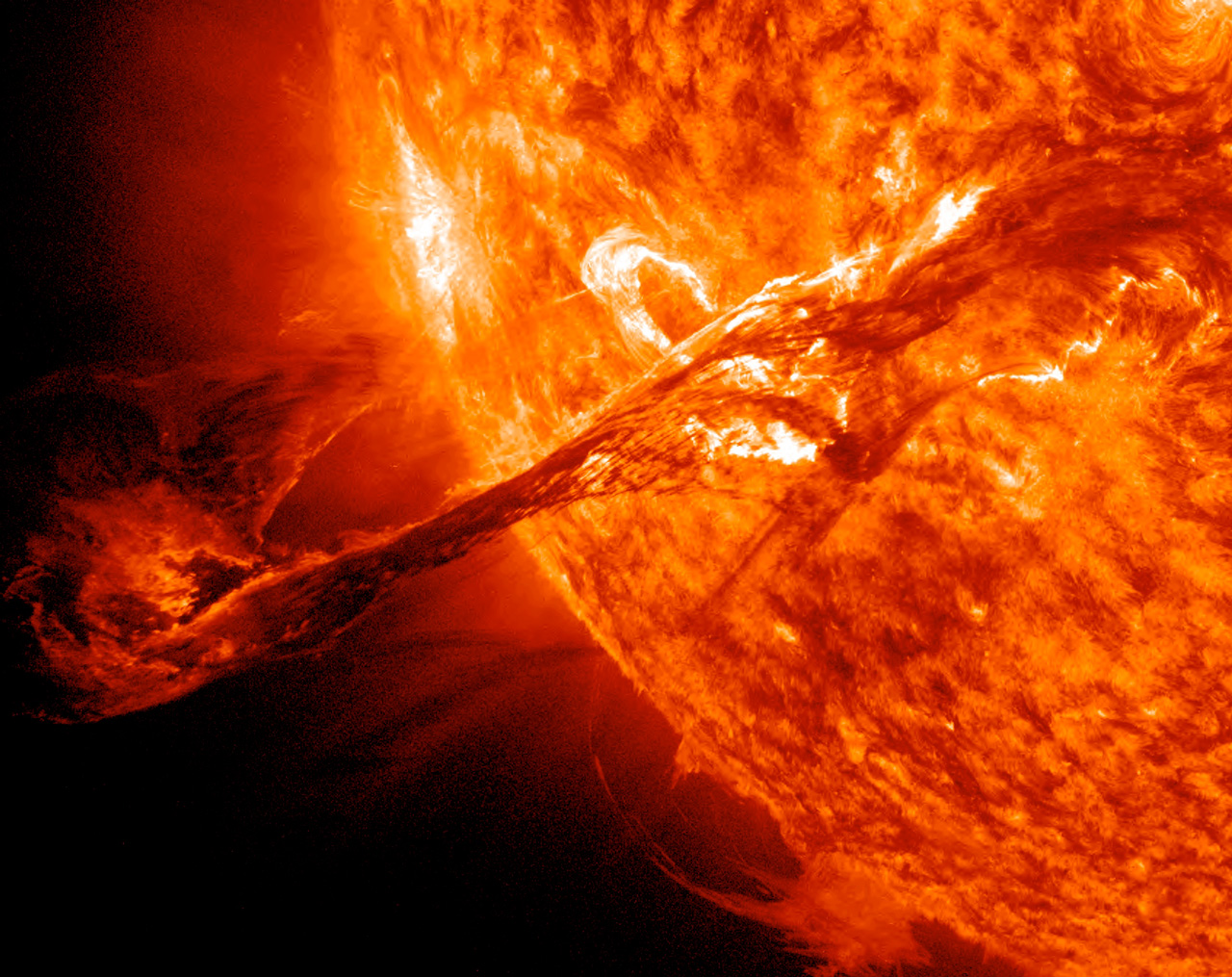Expanded from question three of the big three heliophysicist investigative questions: What causes the Sun to vary? Learn more ›
The Sun releases energy in two ways: the usual flow of light that illuminates the Earth and makes life possible; but also in more violent and dramatic ways--it gives off bursts of light, particles, and magnetic fields that can have ripple effects far beyond Pluto. The Sun is made of super-hot ionized gas called plasma. The Sun's surface and atmosphere changes continually, driven by the magnetic forces generated by this constantly-moving plasma.The Sun's plasma is so hot that the most energetic charged particles can escape from the Sun's gravity and fly away, out into space, called the solar wind. The solar wind defines the region around the Sun known as the heliosphere.

Best Practice! Using Guiding Questions to Drive Inquiry
Each big idea has student-friendly questions written at different levels that you can use to guide inquiry-based investigations at the appropriate level. Explore this big idea at each level below, with featured resources you can engage learners with.
Introductory Learner
Guiding Question: What is the Sun made of?
Standards: PS1
Heliophysics Narrative:
- The Sun is a star, as seen up close, and is the center of our solar system. Stars are made of a type of matter called plasma, which is a superheated gas.
- Students in grade 2 can describe the three different kinds of matter and begin to observe the properties of different materials at different temperatures (2-PS1-1). By grade 5, they can describe that all matter is made of particles and that the motion of the particles determines the state of matter (5-PS1-1).
- Connect to the Sun by introducing plasma as the 4th state of matter, keeping in mind that at this level students don't understand ionization. But students can understand that plasma has more energy than gas. At grade 5 they can begin to explore how plasma particles are spread out and move around randomly. The Sun is made of plasma, which is very, very hot. Plasma is hotter than gas.
- Expand student exploration by giving students examples of plasmas on Earth, which include lightning, simple plasma balls, aurora (upper atmosphere).
- Support younger students by exploring particle motion and emphasizing that plasma particles move faster than gas particles.
- Challenge students at the next level by exploring the properties of plasma.
Featured Resource: Our Very Own Star the Sun Coloring Book ›
Intermediate Learner
Guiding Question: How do the magnetic fields of the Sun compare to the magnetic field of the Earth?
Standards: PS1, PS2, ESS2
Heliophysics Narrative:
- Many objects in the universe have magnetic fields. The Sun's magnetic field is created by the churning plasma below the Sun's surface, whereas the Earth's magnetic field is created by the spinning molten iron core of Earth. While both the Sun's and Earth's magnetic fields fluctuate and their magnetic poles flip, Earth's poles flip on the timescale of hundreds of thousands of years; the Sun's poles flip on the timescale of a decade, approximately eleven years.
- At this level students learn about the properties of the layers of the Earth (MS-ESS2-1) and can identify plasma as a state of matter (MS-PS1-4) and the properties of electromagnetic fields (MS-PS2-5).
- Connect to the Sun by focusing on how the Sun's magnetic field is very different from Earth's magnetic field. Because the Sun's poles flip so often, the magnetic fields of the Sun get tangled up and eventually snap and reconnect, creating enormous amounts of energy, which can cause solar flares and coronal mass ejections (CME). Even when the Sun's magnetic fields are relatively stable, the Sun's hot plasma is always outputting solar wind, which is also made of plasma. The solar wind intensifies with solar flares and CMEs, and transports some of the Sun’s magnetic field out into the solar system.
- Extend students' exploration by pointing out that auroras occur when Earth's magnetic field is disturbed (snapped and reconnected) when intense solar storms hit Earth. While magnetic reconnection on the Sun produces solar flares, reconnection in Earth’s magnetic field produce aurora.
- Support beginner students by reviewing how particle motion affects states of matter (5-PS2-5).
- Challenge students at the next level by having them investigate the electromagnetic properties of plasma. Plasmas are electrically charged and because they move through space they produce a current. Just like the current flowing in a wire, a flowing plasma produces magnetic fields.
Featured Resource: The Solar Cycle As Seen From Space Video ›
Advanced Learner
Guiding Question: What are the properties of plasma and how do those properties make the Sun a giant sphere of massive energy?
Standards: PS1, PS2, ESS1
Heliophysics Narrative:
- The Sun is made of plasma. Plasma is an ionized gas, which creates an electromagnetic field. Plasmas are electrically charged and they move through space, therefore produce currents. Just like the current flowing in a wire, a flowing plasma produces magnetic fields. The vast majority of the Sun's energy output is created at the Sun's core through nuclear fusion. This internal heating converts the gas within the Sun into a plasma. At the surface of the Sun, this plasma boils like a convecting fluid and generates the Sun’s magnetic field, which we can detect at the Sun’s surface. The release of magnetic energy by reconnection also heats the corona of the Sun to millions of degrees celsius, and also produces the plasma within the solar wind.
- At this level, students know that the Sun uses nuclear fusion at its core to make energy (HS-ESS1-6) and are learning about how the motion of electrons and ions in plasma produces its own electric and magnetic fields (HS-PS1-3)(HS-PS2-4,5).
- Connect to the Sun by emphasizing that the Sun is made of plasma and how the properties of plasma create the phenomena we observe on the Sun, including sunspots, solar flares, and coronal mass ejections. Sunspots have intense magnetic fields and repeated ejection activity, where the tangled ropes of magnetic-field lines break through the surface of the Sun itself. They snap and reconnect, releasing huge amounts of energy. Coronal mass ejections (CMEs) are bubbles of coronal plasma with intense magnetic field lines that are ejected from the Sun over the course of several hours. These solar storms are an element of what is called space weather, which can impact technologies on Earth and near-Earth environments.
- Extend student exploration by having them further investigate the physics of magnetic reconnection and how it maintains heat on the surface of the Sun. For example, when magnetic fields change from one shape to another (reconnection), the energy that is liberated in the changing magnetic fields can be used to heat the plasma.
- Support beginner students at this level by finding out what they know about magnetic fields of the Sun and Earth (MS-ESS2-1).
- Challenge students at the next level by having them investigate the more complex magnetic reactions that occur inside the Sun, known as a magnetic dynamo.
Featured Resource: Student HelioViewer: Solar Data Interactive ›
What level are my learners?
Introductory: A younger learner (K-5), or a learner new to the subject matter.
Intermediate: A middle-aged learner (6-8), or a learner that has some familiarity with the subject matter.
Advanced: An older learner (9-12+), or a learner that has a lot of experience with the subject matter.
Note: Next Generation Science Standards (K-12) are mapped to the resources accordingly.
What is a NGSS Heliophysics Narrative?
NGSS Heliophysics Narratives support educators with the incorporation of heliophysics concepts and resources into their existing curricula. The narratives consist of relevant heliophysics background information, applicable NGSS performance expectations, and guiding questions to spark inquiry-based learning at the appropriate level.
Narrative Structure:
- Short answer to the question, for teacher background knowledge
- An analysis of NGSS Performance Expectations (PE) to determine learning constraints at each level
- Heliophysics topics that connect to the NGSS PE and can be infused into teaching systems science
- More heliophysics to explore
- How to support beginner learners
- How to challenge learners at the next level





